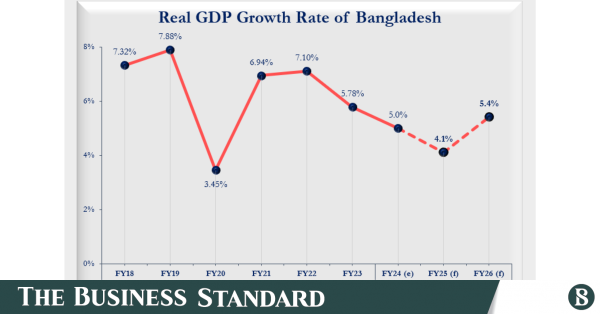Highlights:
- Economic growth of Bangladesh set to slow down to 4.1% in fiscal year 2024-2025
- Country’s investments will remain bleak due to political turmoil
- Economic growth will gain pace in FY26 with a 5.4% rate
- Growth in the region excluding India is set to reach to 4% in 2025 and to 4.3% in 2026
- Growth in developing economies is also expected to hold steady at about 4% over the next two years
Bangladesh’s economic growth is set to slow down to 4.1% this fiscal year (FY25), the weakest pace since the pandemic, as political turmoil in mid-2024 weighed on activity and deteriorated investor confidence, the World Bank said yesterday (16 January).
In its latest edition of Global Economic Prospects report, the global lender warned amid heightened political uncertainty, the country’s investment and industrial activity are expected to remain subdued in the near term.
Growth has already decelerated for two consecutive years, with the World Bank estimating FY24 expansion at 5%.
This figure contrasts with provisional data from the Bangladesh Bureau of Statistics (BBS), which reported growth at 5.82% but has yet to finalise the numbers.
“Supply constraints, including energy shortages and import restrictions, weakened industrial activity and led to increased price pressures,” the report highlighted. “High inflation reduced the purchasing power of households, slowing services growth.”
Despite the dismal short-term outlook, the World Bank remains cautiously optimistic about the future, projecting that Bangladesh’s GDP growth to pick up to 5.4% in the next fiscal year (FY26), assuming broad political stability, successful reforms in the financial sector, an improved business climate, and increased trade. Easing inflation is expected to boost private consumption.
Nevertheless, the immediate economic picture remains grim. Recent BBS data revealed a marked slowdown across Bangladesh’s three key GDP components—agriculture, industry, and services—in the first quarter of FY25.
The provisional figures are alarming. According to BBS, GDP growth slowed to just 1.81% in the July-September period, the slowest pace in 15 quarters or nearly four years.
This stands in stark contrast to the 6.04% growth recorded in the same period last fiscal year.
Meanwhile, a month ago, government has revised its GDP growth projection for FY25 downward to 5.25%, from the initial estimate of 6.75%.
South Asia’s economic outlook
Growth in South Asia is expected to remain high over the forecast period, averaging 6.2% in 2025-26, with the high level driven by resilient activity in India, reads the report.
Growth in the region excluding India is set to reach to 4% in 2025 and to 4.3% in 2026, though the forecast for this year is slightly lower than in June last year’s projection mainly due to a downgrade for Bangladesh amid economic and policy uncertainty.
In India, growth is projected to remain steady, at 6.7% a year for the two fiscal years beginning in April 2025. The services sector is expected to enjoy sustained expansion, and manufacturing activity will strengthen, supported by government initiatives to improve the business environment. Investment growth is projected to be steady, with moderating public investment offset by rising private investment.
Growth is expected to strengthen in Pakistan to 2.8% in FY2024/25 (July 2024 to June 2025) and 3.2% in FY2025/26. Moderating inflation will support industrial activity, while reduced uncertainty is envisaged to improve business confidence, boosting investment.
In Sri Lanka, strong industrial activity and recoveries in remittances will support growth of 3.5% in 2025 and 3.1% in 2026.
Resilient tourism is also projected to underpin growth in Bhutan, Maldives, and Nepal. The economy is envisaged to see modest expansion in Afghanistan, while unemployment, food insecurity, and poverty are heightened.
Major downside risks include heightened policy uncertainty and adverse trade policy shifts in major trading partners, as well as higher commodity prices.
Other downside risks include heightened domestic violence and social unrest, a slower pace of monetary easing and larger debt-service burdens, more frequent extreme weather events, and slower-than-projected growth in major global economies.
An upside risk is stronger-than-expected growth in major economies, which would increase global demand and economic activity in the region, highlighted the report.
Global economy stabilizes, but developing economies face tougher slog
Developing economies – which fuel 60% of global growth – are projected to finish the first quarter of the 21st century with the weakest long-term growth outlook since 2000, said the World Bank.
Even as the global economy stabilizes in the next two years, developing economies are expected to make slower progress in catching up with the income levels of advanced economies.
The global economy is projected to expand by 2.7% in both 2025 and 2026, the same pace as in 2024, as inflation and interest rates decline gradually.
Growth in developing economies is also expected to hold steady at about 4% over the next two years.
This, however, would be a weaker performance than before the pandemic – and insufficient to foster the progress necessary to alleviate poverty and achieve wider development goals.


